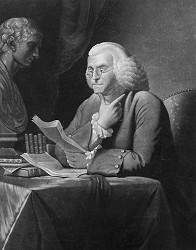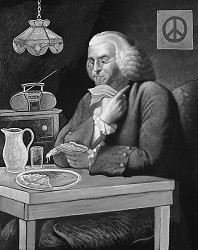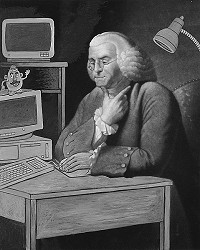Lesson Plan 3
Objects as Self
Objectives
Observe how objects and setting help to define a portrait subject.
Create a self-portrait that emphasizes objects and setting.
Materials
copies of the images
on these pages
art supplies
photographs of
students (optional)
heavy paper
scissors
glue
Subject
visual arts
The image to the right is an engraving based on a portrait painted in 1767, when Franklin was in London as a representative of the colonies. The images below that are by Ted Lind, director of education at the Albany Institute of History & Art.
As an introduction to a self-
portrait exercise, you might show students these pictures and ask questions along these lines: How do the changes in the new portrait affect your impression of Franklin? Do the changes make the objects in the original portrait more
noticeable? Do the original objects help us understand what the artist wanted to say about Franklin? What are these defining objects? (The bust, by the way, is of
Isaac Newton.)
Procedure
1. Ask students to bring in a full-body photograph, or have
them draw a full-body self-portrait.
2. Photocopy the photographs
or drawings, enlarging them if
possible.
3. Have students clip out these photocopied images so that they are somewhat like paper dolls.
4. Assign an exercise in which they attempt to express self through setting and objects only. This might be a drawing of a
room containing favorite objects, or it might be a magazine-picture
collage of things that represent their backgrounds, interests,
and aspirations.
5. Have them glue the
“paper doll” image onto this
setting to create a new portrait.
Ask students to think of their work as if it had the importance of portrait painting in Franklin’s time, when this was one of the few ways of making a visual record of a
person’s life. The eighteenth-
century painter Jonathan Richardson wrote that “to sit for one’s picture is to have an abstract of one’s life written, and published, and ourselves thus consigned over to honor or infamy.”
Let’s say that someone wishes
to express, above all, a devotion to the Backstreet Boys. You might offer some questions for consideration: Is this the best way to explain to people in the future the sort of person you were? Are you sure that your feelings for the Backstreet Boys will prove more enduring than those you had for, say, the group Hanson two years ago?
Before students affix the photocopied images of themselves, you might display their “objects as self” portraits and ask the class to guess, on the evidence of the chosen objects, the identities of the artists.
This lesson plan was adapted from an activity in the portable exhibit Facing Portraits, created by the Education Department of the Albany Institute of History & Art. Ted Lind created altered images of Franklin using the Institute’s copy of the engraving.
|
|

Benjamin Franklin, by Edward Savage, after Benjamin West, after David Martin, mezzotint, 1793. National Portrait Gallery, Smithsonian Institution, Washington, D.C.

Benjamin Franklin, by Ted Lind.

Benjamin Franklin, by Ted Lind.
|



